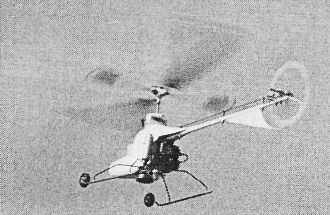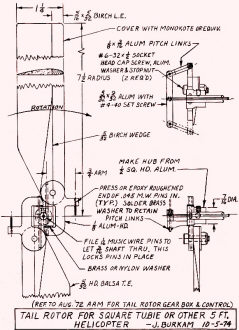|
Even in 1975 when this "Helicopter
Action" column appeared in American Aircraft Modeler magazine a very
small percentage of R/C fliers had ever even tried their hands at helicopters,
and an even smaller portion had been successful enough to keep at it. Gyroscopes
for tail rotors were still in the prototype development stage, fixed pitch rotor
blades were the norm. Control over the rotor disc was not by direct linkage to
the blades, but to a rotor head assembly with a flybar. Only two servos were
used - one for left/right and one for fore/aft. When setting up controls to the
swashplate, accounting for gyroscopic precession was required since the desired
output is 90° from the input in the direction of rotation. It was
counterintuitive to the fledgling helicopter setter-upper, but like magic, it
worked. It was during the setup of my
DuBro TriStar helicopter
that I first learned of the concept (I was 18 years old). I say all that to say
this: Given the advanced state of the art in R/C helicopters today you might
think that making a big deal of something as tame as a heli pylon race or
performing a loop-the-loop is ridiculous, but these guys were driving the
technology forward so that we might enjoy the models we have now.
Helicopter Action
 John Burkam on Helicopters John Burkam on Helicopters
Drag Racing: It finally happened at a helicopter contest in Toledo, Ohio. Dave
Keats said that the "expert fliers liked two things, pylon racing (two at a time)
and an impromptu drag race (two or more at a time). Everyone especially liked the
drag racing, which was not part of the contest. The racers started from the ground
at the drop of a flag and went the length of the runway (timed). If you were good,
you touched a skid two or three times down the course. The Polecat (mine) won the
pylon race and was second-fastest in drag racing (flat out before end of course).
Bill Curtiss' Polecat II was superfast.
Dave will probably give more details of the contest in his excellent column in
another magazine. I predict that drag racing and/or pylon racing with choppers will
grow in popularity fast!
Eastern States Helicopter Contest highlights: Dave Gray won the Expert Precision
event in this NRCHA and Du-Bro sponsored contest. Since each man flew all four tasks
in sequence, nerves were a little frayed by the end.

Ed Sweeney's Superbird modification to
Du-Bro's Whirlybird 505 (AAM December,
1973) is still going strong. It uses a 19 engine.
This became even more noticeable in the second round, as some machines bounded
to 20 ft. in height when they were supposed to stay below 5 ft. in the slalom course.
Dave was master of the situation, however. Others in the first five places were
Don Lowe, Ron Wiensch, Dave Keats and Grady Howard. The novice event, flown inside
the hangar, was won by Tom Herr, an up-and-coming youngster. (The noise in there
was deafening, even with mufflers.)
John Werne and Gene Rock battled it out for first and second, respectively, in
Stand-off Scale. Gene's four-bladed, hingeless, rotored BO-105 probably was truest
to scale, even to the correct number of blades on both rotors. But John's beautiful
Hughes 300 had more details (such as insignias, louvres, boots on the landing gear
oleo struts, etc.) which were visible from 10ft.
The loop competition would have been won by John Burkam if his tail rotor blades
hadn't parted company with the rest of the machine after the first 45° of the
loop. Three cartwheels and a nose dive from 100 ft. up! He should have received
an award for the most spectacular crash. Dave Keats nearly looped his Polecat, but
it rolled out at the top. Neither Faye Peoples nor Grady Howard, with much heavier
machines, could get the noses of their helicopters quite straight up.
On Looping: Not only must a helicopter have power and streamlining to achieve
high forward speed, it also must have enough excess thrust so that when it pulls
its nose up, it will not stall the blades and dissipate that horizontal kinetic
energy before it's converted into vertical kinetic energy.
Then, over on its back, it must have enough speed to respond to aft stick and
put its nose down. (Not like Faye Peoples' ship did the other day - screwed itself
into the ground inverted from 400 ft. up!) One way to avoid that situation is to
have a horizontal stab of at least 1% of the rotor disc area back by the tail rotor.
That insures the tail going slower than the rest of the fuselage on the way down.
Due to my recent Figure Nine maneuver, no more rigid rotor experiments will be
performed on Square Tubie. Instead, a new tail rotor design is presented here to
replace the one in which the pressed-in pins pulled out of the hub. This one is
called a door hinge hub. The bending moments from the blades are taken mostly in
shear in the pitch bearing pins, and the centrifugal force is taken in compression
by the nylon or brass washers.
If desired, the blades can be turned around to make the hub rotate the other
way. Then the pitch arms would trail the blades, as in the previous tail rotor (August,
1972, AAM). When the yaw servo pulls on the tail rotor control cable, pitch is increased
as before.

Tail rotor for "Square Tubie" or other 5 ft. helicopter.
Another suggestion for improving Square Tubie: Replace the Stock Drive Products
No. 1C4-Y3216 mitre gears on the intermediate shaft and tail rotor takeoff with
the next size larger, 1C4-Y3224. The smaller ones were found to have only about
15 min. of life left in them after the record flight. The tail rotor gear box is
OK as is.
WCCHC: The West Coast Championship Helicopter Contest, held Sept. 22, was won
by John Minasian, followed by John Simone Jr., Nate Rambo and John Gorham, all flying
Kavan Jet Rangers. Fifth place went to Chris Spangenberg flying an original design
with Du-Bro mechanics. The Novice Class had all Jet Rangers, and the first three
places went to Bob Mearns, Ed Von Websky and John Simone Sr. Ernie Huber took a
day off and won only Best-in-Scale with his Bell 212 rescue aircraft, fitted with
Kavan mechanics. (I understand that the NATS at Lake Charles also was a "Kavan show.")
None other than Charles Gilbert won best scratch-built with an original design.
Maneuvers were a balanced diet of slow and fast, namely: (1) Hover; (2) Constant
heading square; (3) Pick up hoop, carry it around pylon and return it to pick-up
point; (4) A series of different kinds of takeoffs and forward flight maneuvers
for experts only (180° turns downwind and upwind, cloverleaf, 360° pirouette,
"Ag turns" or stall turns, quick stop, steep descent, etc.)
The past year has seen a delightful variety of maneuvers and events in the five
or more helicopter contests held. The AMA Helicopter Advisory Council now should
be able to start putting together their provisional rules. These should include
both judged and timed events to show off both pilot skill and helicopter performance.
Help wanted. Noted model helicopter designer desires partners to build and de-bug
his latest designs for eventual publication in AAM. Drawings furnished free along
with pieces of the harder-to-get materials, if needed, in exchange for clear pictures
of the model and constructive criticism of the design, how easily it went together,
how it flies and how it can be improved. Applicants should be experienced (not necessarily
expert) model helicopter fliers and machinists.
New design ready for building is a 44" rotor, 19-powered aerobatic helicopter
of similar construction to the Polecat by Dave Keats. Full credit for building,
pictures and ideas will be given.
Posted December 18, 2022
|




